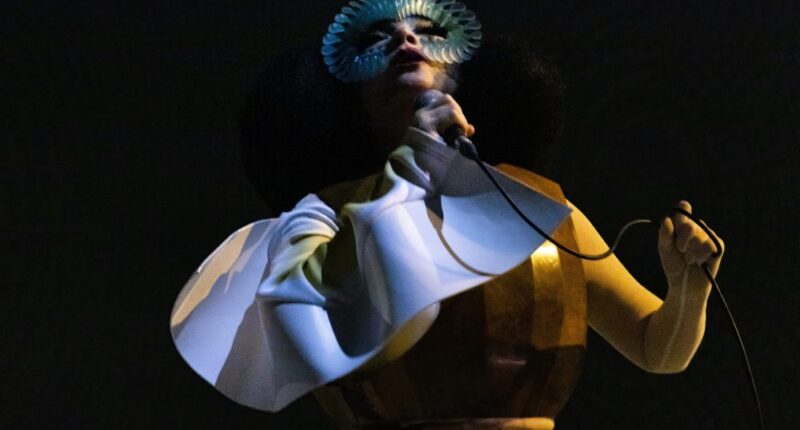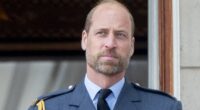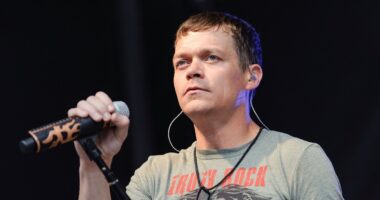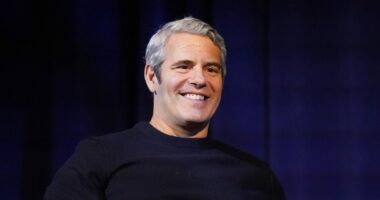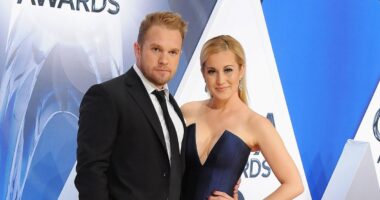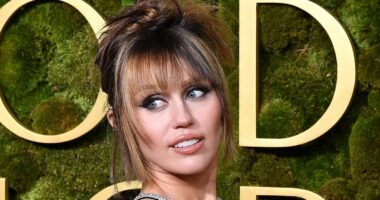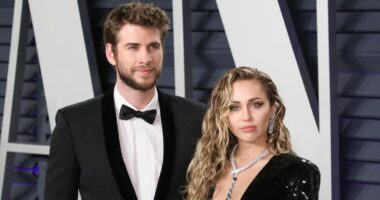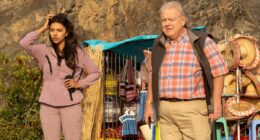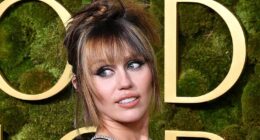In talking about her new concert movie, “Björk: Cornucopia,” the movie’s namesake mentions the way the performance in the film wraps up, and the finally hopeful message she wanted to get across with it.
She says the ending of the movie has “Love will save us from death” as its climactic message, “which I highly believe in. It is a strange reply to the goths of Joy Division’s ‘Love Will Tear Us Apart.’ I want optimistic goth,” she declares. For emphasis, she adds: “Albino goth is what I am going for here.”
Reaching that exhilarating conclusion on stage was a typically awe-inspiring experience, as captured in “Björk: Cornucopia,” the enchanting concert film illustrating her extensive five-year tour that debuts in theaters worldwide today. (Details on tickets and cinema locations for the film can be accessed here.)
When you ask the Icelandic audio-visual arts icon to go deep on the tour-turned-movie, she goes deep. That’s to be expected in talking about a project that uses fantastical imagery to experimentally and explosively plumb the emotional depths of the albums that made up her “Cornucopia” tour set list – the healing, post-breakup music of “Vulnicura,” the vivid life-death cycle of “Fossora” and the myth, mirth and uplift of “Utopia.”
The tour welcomed bespoke instrumentation (magnetic harps, circular flutes) and oft-surreal VR visuals to populate her haunting story’s self-made “sci-fi” world. As the tour and film’s “sound and visual director,” Björk coaxed and curated an immersive universe of digitally animated moving curtains (a modern lanterna magica), electric vulvas, propulsive snow, spiraling twines of light and angel-winged instrumentalists playing in Dolby Atmos spatial audio. Filmed live at a 19th century theater in Lisbon, the digital-meets-analog display of “Cornucopia” has little to which you can compare its nuances or newness, save for the tour from whence this cinematic experience came.
Answering questions via email, complete with a handful of “kindas” in her written responses, Björk is as engaging and singular a conversationalist as she is a sound and visual artisan.
With “Utopia,” you concocted a sonic language for both a perfect fantasy – your best dreams, the listener’s idea of paradise – as well as what was potentially on the other side of that fantasy, including how dreams are corrupted. By the time the tour that “Cornucopia” documents had finished, had your dreams and hopes evolved?
I think that even though I named an album “Utopia,” I knew it was not only about our desire for a sublime world, but also that it expresses how we feel when this does not work out. Our disappointment. It is emotionally almost more about that desperate reach in humans, how we try to grasp the ideal life. And I think my own personal expectations are in tune with that; understanding that things are changing very slowly and that there is a lot of effort. It’s a marathon. But, of course, there is a huge urgency to dream. We have to hope — not only in our personal lives, but also when it comes to global things like climate-change. The Paris Climate Accord is a kind of utopian desire. All the things in it will be incredibly difficult to reach. But if we only rise to half of them, it is worth the effort. It was tragic when the United States left the accord the second time. I do hope Trump rejoins it.
“Utopia” was the main element of the “Cornucopia” set list. What did you see as its most prominent visual elements? What were the things in life and dreams that stuck out for you optically or graphically?
For me, it starts as a sound. After “Vulnicura,” which was my heartbreak album — all stark, barren, wintery sonic songs — I was desperate for the opposite. The sound of ecstasy, summer and celebration. So, I catapulted into the elements — air, synths that sound like flutes, flutes that sound like synths — to match the emotional need to float up into the air like a helium balloon after grief. Usually, after I have recorded an album, in order to keep my team synchronized, I will often gather together a visual palette to describe the sound world we are after. I remember talking about the color palette of mint green and peach, and textures, textiles and timbres all airy and fluffy to match the flutes. I also remember mentioning baby albino giraffes and a sci-fi-island in the sky.
From past projects, we know that you’re a passionate curator-collaborator. Can you discuss how you translated your vision as “sound and visual director” of “Cornucopia” to director Ísold Uggadóttir, your choreographers, stage directors and additional background filmmakers such as Tobias Gremmler?
I have been the only one involved in this project from the beginning to end, and I have worked one-on-one with every person involved. So, it is very much my baby. I speak a kind of different language to different people, whether they were DPs, lighting people, animators, editors or directors. We had three directors, actually — one for the theater show, another for the film and me. Overall, I described to all of them how to create with me a sci-fi island in the clouds with a flock of women who go to this island to escape violence and start anew with flutes. So it has this pastel color sweetness, but with an edge; a little absurd, which matches with the emotional urge in humans for a better world. And it is desperate, therefore, the distortion.
I remember asking (costume designer) James Merry to help me change into a mutant, like the humans are changing into plants, and if he could alter my skin into a biological orchid. To that end, he created and sculpted forms out of silicon that he glued to my face. I also remember asking Tobias how he could make erotic, ecstatic plants, describing how they had to be fantasy ones. All of this was about the creation of a new world, so it had to be moist and lubricated. This was a post-optimistic world where new exciting collisions in biology had blossomed. From my experience of working in the music-video format, I have experience of always highlighting synesthesia, an extreme accuracy in syncing the emotion in each song to its visuals. So, each 10 seconds of screen time gets discussed. Plus, I wanted a Times Square-kinda-sensory-overload with seven screens opening and closing through each song in a similar way that editing happens in films, so that dozens of times within each song, the image is coordinated with the feelings of the music.
“Björk: Cornucopia”
Santiago Felipe
Although the “Cornucopia” tour was primarily centered around tracks from “Utopia,” it also incorporated the more poignant elements of “Vulnicura” and “Fossora.” What palettes and themes from both of those albums were explored? How were they integrated into the overarching concept of “Utopia”?
I felt as if adding “Family,” “The Gate” and “Notget” from “Vulnicura” into the show served the same purpose as prequels. It is the reason that we find ourselves in this ecstatic “Utopia.” When I chose the happy songs from “Fossora” — “Ovule, “Fossora,” “Atopos” — they represented more of my fungus underworld botanical angle, so it was easy to add them. I think that, emotionally, this worked in the dramaturgy because “Utopia” is about the “dream” and “Fossora” is about the real or the execution of the dream into day-to-day life. I feel as if how we experience, emotionally, the chronology of our daily lives isn’t always linear in time.
A song like “Notget,” for example, is our end song, just as it is on “Vulnicura” (the album). But it has a message about love, and conclusion, which makes it a potential finale track for “Cornucopia” with its “Love will save us from death” as a message, which I highly believe in. It is a strange reply to the goths of Joy Division’s “Love Will Tear Us Apart.” I want optimistic goth … Albino goth is what I am going for here.
So, it’s fair to say that after the sad events behind “Vulnicura,” you were looking to create something freeing and ecstatic?
Yes. I think so … like the joy after the catharsis, the calm after the storm. But also something ideological. I feel like after traumas, people come up with manifestos for the future that are often idealistic, like a recipe for survival. “Fossora” is when you act them out in real life.
I witnessed a Shed NYC residency performance of “Cornucopia” before you released “Fossora” in 2022. Did writing and recording that through your mother’s passing shift the tour’s visual and sonic messaging in any way?
There are two songs on “Fossora” about my mother. The rest of the songs there are more happy, ecstatic and uplifting. I do think the songs about my mom almost could be on a separate EP. I am actually going to exhibit them (their visuals) in Iceland for the 2026 solar eclipse as a visceral museum piece.

“Björk: Cornucopia”
SantiagoFelipe.com
“Cornucopia” delves into the feminine divine, drawing inspiration from the legends of Africa, Asia, South America, and Scandinavia, where women derived strength from flutes. In times of peril, these women would depart with their offspring and flutes to a new utopia devoid of conflict… and men. Upon the return of men, chaos ensued… yet, you, the children, and the flutes navigated through it. How have the masculine energies and global socio-political dynamics that we have recently encountered influenced your artistry – particularly in the progression of a production like “Cornucopia”?
I would like to highlight here that there exist pacifist men and violent ladies …. but in “Cornucopia,” I am dealing more with masculine aggressive energy, especially after having experienced having a child in school two hours away from Sandy Hook, and living partly in a country with one mass shooting a day. I come from a country with no army and almost no crime, so all this was devastating for me; to try to navigate philosophically through this, with my mothering instincts kicking high.
The “Cornucopia” film has so many moving pieces. How did you make it happen seamlessly? What moments offered the most challenges in going from the records to stages to documenting that on film? What solutions did you and your director find to make it work?
I worked for a decade in 360 visuals and sound, as “Biophilia” and “Vulnicura” were apps on touchscreens and in VR headsets. I had been working with animation programmers, working on “Unison” among other things, innovating new 360 sound mastering software, and so on. In short, “Cornucopia” was about taking the visuals out of a VR headset, then onto a 19th century stage, making it physical and alive but keeping the circular energy.
The ultimate heart of the film for me was “Arisen My Senses,” so I started working with Tobias Gremmler on this, being super precise about syncing the harp-MIDI with the straws in the animation, and making it all feel as it was blooming, blooming, blooming. This is when I worked out that we needed 27 screens to open and close through the whole song with curtain choreography changing every few seconds. Additional songs were done in the same way, like “Courtship” and “Loss.”
Then we had the total opposite because I wanted to counter all the digital-ness with something extremely analog, and the song which displayed that look best was “Body Memory.” There we removed the screens, took away the “magika lantera” effect and added a 50-piece choir, seven-meter-long organ pipes, a circular flute, bespoke magnetic harp and more. So, I wanted it all to be as dynamic as possible. Try to go from intimate fragile solos to bombastic group moments. The reason I call it “digital theatre” is that I wanted it (“Cornucopia”) to carry the best of all worlds, from extremely digital, hi-res fantastical animation to lo-fi live theater where you are one-on-one with the performers.
Why did you pick “Cornucopia” as a title? What bounty do you wish those who enjoy it get out of seeing it?
When I started working on the choreography for the flutes with (“Cornucopia”) choreographer Margrét Bjarnadóttir in 2018, I knew that the ambition I had for taking “Utopia” live to stage would be so work-extensive and practically impossible to travel with that I calmed my long-time manager down by saying that the screens and the work we were working on weren’t just for one album, but two. So, I named it not after the album, but “Cornucopia,” knowing it would be a vessel for many more things. COVID came and worked in my favor, halfway through the tour, and I had to stop and write a whole new bass-clarinet fungus album. Then when we did the second half of the tour. By then, it had become a more fully formed thing… a sci-fi-island in the sky with soil and fungus roots underneath it.
